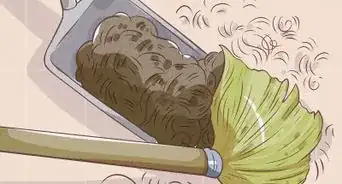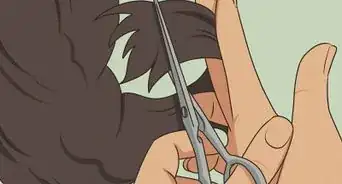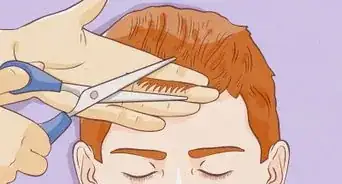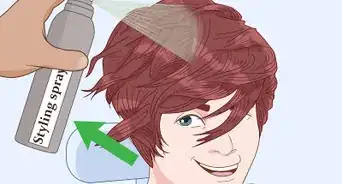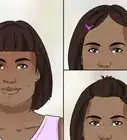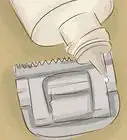This article was co-authored by Arthur Sebastian and by wikiHow staff writer, Hunter Rising. Arthur Sebastian is the Owner of Arthur Sebastian Hair Salon in San Francisco, California. Arthur has worked as a hair stylist for over 20 years and received his Cosmetology License in 1998. He believes that the true work of a successful hair stylist comes from passion and a love for hairdressing.
There are 16 references cited in this article, which can be found at the bottom of the page.
This article has been viewed 122,405 times.
A medium-length men’s hairstyle, which is usually 2–4 inches (5.1–10.2 cm) long, can be more challenging to maintain than short hair since it’s difficult to make it look uniform. If you cut hair so it's all the same length, it won't have a lot of definition and it may look flat. By adding layers to medium-length hair, you can make the style stand out even more. While every head of hair is different and people will want varying styles, you can easily trim their hair as long as you have a bit of patience and the proper tools.
Steps
Sectioning the Hair
-
1Wet the hair with a spray bottle until it’s damp so it’s easier to work with. Fill a spray bottle with water from a sink and mist the person’s hair. Work through the hair with a comb as you mist it to help dampen the hair underneath and remove any snags or tangles. Only apply enough water so the hair is damp to the touch but not soaking wet.[1]
- If the person has greasy or dirty hair, wash the person’s hair with shampoo first before patting it with a towel until it’s damp.
Variation: If the person has very curly or wavy hair, avoid wetting their hair. Curly hair looks longer when it’s wet so cutting it while it’s still dry will give you a more accurate idea of what their hair will actually look like.[2]
-
2Gather the hair on the top of the head toward the person’s face. Use a barber comb that has fine and wide teeth so it’s easier to work through the person’s hair. Take all of the hair from the crown of the head and comb it toward the person’s face. Follow the natural part around the person’s head, which will look like a horseshoe shape, to keep the top separate from the back and sides of the head.[3]
- Separating the hair into sections allows you to work more efficiently and easily see the areas that you’ve already cut.
- Be careful not to pull too hard while combing through the person’s hair just in case there are still snags. Gently work through them with your comb until the strands separate.
Advertisement -
3Secure the hair on top with a hair tie or clip. Gather as much of the hair on top of the person’s head by hand and hold it above their scalp. If you’re using a hair tie, slide one off of your wrist and wrap it around the gathered hair 1–2 times so it stays in place. Otherwise, secure a clip to the hair so it doesn’t fall down on the sides while you’re working.[4]
- You don’t need to use a hair tie or clip if you don’t want to, but you may lose the visible part while you’re working if the person moves their head.
-
4Comb the hair on the sides and back of the head straight down. Start from the top where you parted the hair and bring the person’s hair straight down with your comb. Work completely around the person’s head to straighten their hair around the back and sides. Be careful not to pull any of the hair from the top of the person’s head down, or else you may need to start over.[5]
Trimming the Back and Sides
-
1Comb out a vertical section of hair on the side of the person’s head. Start on one side of the person’s face just in front of their ear. Comb a section that’s about 1 inch (2.5 cm) wide forward so it’s separate from the rest of the person’s hair. Place the comb along the roots and pull it straight out towards the ends of the strands so they form a 90-degree angle to the person’s head.[6]
- Avoid working with larger sections of hair since you won’t be able to cut them as easily.
-
2Pinch the hair between your index and middle fingers at the desired length. Use your nondominant hand to grip the section of hair as close to the roots as you can. Keep the back of your hand closest to the person’s head and your palm facing you. Slide your fingers along the strands behind your comb, making sure the hair stays straight perpendicular to their head. When your palm reaches the length you want to cut the hair to, stop moving your fingers and squeeze them together tightly.[7]
- Typically, medium-length men’s hairstyles are around 2–4 inches (5.1–10.2 cm) long, but the person may want something different for their hair.
-
3Cut the hair vertically with hair-cutting shears so the ends are square. Hold your shears so the blades point face down so they’re easier to work with. Snip the hair from the palm side of your hand using short downward strokes so the ends of the hairs are even and line up with one another. After you make your cut, let go of the section so it falls back toward the person’s head.[8]
- You can buy shears made for cutting hair online or from beauty supply stores.
- Trimming the ends of the person’s hair so they’re square creates a tapered, layered look that’s lighter and easier to work with. It will also make the hair blend together more easily.
Warning: Avoid using regular scissors to cut somebody’s hair since you could damage the ends and it won’t look as uniform.
-
4Work around the back of the head in sections until you reach the other side. Comb the next 1 in (2.5 cm) section of hair away from the person’s head and grip it with your fingers at the same length as the first one. Use your shears to square off the ends of the hair before moving on. Go completely around the back of the person’s head so you end in front of their other ear.[9]
- If you aren’t able to grab all of the hair in the vertical section, work from the top to the bottom. As you adjust your grip, hold some of the hair you already cut from that section to use as a guide so you know how long to cut the lower strands.
- If you’d rather have a uniform length for the hair on the sides and back of your head, you can also use clippers with a guard. Work from the bottom towards the part in straight strokes, lifting the clippers away as you finish each cut. This works well if you’re giving the person a fade or undercut.
-
5Check horizontal sections of hair and trim strands that are too long. Start on either side of the person’s head at the part in their hair. Drag your comb through a horizontal section that’s 1⁄2 inch (1.3 cm) wide and grip the strands between your fingers. If you notice any hairs that are longer than the others, use your shears to trim them straight horizontally. Work your way down and around the person’s head to ensure the ends are uniform.[10]
- Be careful not to cut the hair too short in sections closer to the top of the person’s head since it could make it look like they have a bald spot.
-
6Trim around the ears and neckline with clippers to make a clean edge. Use clippers without a guard so you can cut as close to the skin as possible. Comb the hair on the sides of the person’s head back so it goes over their ears. Carefully guide the clippers around the person’s ear to create a clean line. Bend the person’s ear forward to trim the hair behind it. Repeat the process on the person’s other ear. Then, straighten out their neckline to get rid of any stray hairs.[11]
- Be careful not to hit the person’s ears with the clippers since it could be painful for them.
- You can also use your shears if you don’t have any clippers. Only work with the tips of the blades so you’re less likely to cut the person.
Layering the Top
-
1Split the hair into a middle part so you can work in sections. Undo the hair tie or clip holding the person’s hair up and straighten it out toward the person’s face again. Find the middle of the person’s head and separate their hair to make a part running down the center. Follow which direction the hair naturally falls on their head so you can make more accurate cuts.[12]
- It’s okay for the hair from the top of the person’s head to overlap the hair on the sides or back.
-
2Comb out a vertical section that has hair from the top and side of the head. Start near the person’s face and hold your comb vertically. Separate a vertical section that’s 1 inch (2.5 cm) wide toward the person’s face so it contains some of the hair you cut from the sides. Pull the hair straight out away from the person’s head so you can easily see the length.[13]
- The hair you already cut on the sides will act as a guide so you know how long to cut the ends on top to create a layered and tapered look.
Variation: If you don’t want the hair on top of the person’s head to blend into the sides, like if you want the hair on top longer than the sides, comb out horizontal sections of hair starting at the part and working toward the middle of the person’s head. Don’t include any hair from the side of the person’s head in the combed-out section.
-
3Pinch the section between your fingers at the shortest hair’s length. Keep your palm facing you and grip the section of hair tightly between the index and middle finger on your nondominant hand. Make sure you can see the ends of the shortest hairs so you’re able to use them as reference for how long to cut the rest. Keep the hair pulled tight, or else you may not cut them correctly.[14]
-
4Use your shears to cut the ends square with the shortest strands. Keep the blades of your shears vertical and cut using your dominant hand. Start at the bottom of the section so the blades are perpendicular to the shortest strands of hair. Make small cuts going straight up, using the tips of your shears so you have the most control.[15]
- If you want to leave the hair on top longer than the sides, you can the ends to any length. Just make sure the ends of the hair on top are square with one another instead of squaring them up to the sides.
- If you weren’t able to cut all of the hair in the vertical section, adjust your grip toward the top of the person’s head so you’re still holding some of the hair you just trimmed. Be sure to keep the ends of the hair square as you work.
- Cutting the hair from the top of the person’s head so it’s square with the sides doesn’t mean it will be the same length. Since the roots from the hair on top are higher up on the person’s head, you won’t have to trim as much off the ends, which leaves the top longer and helps it blend into the sides.
-
5Work your way around the head in sections until you reach the other side. Take the section of hair that’s right next to the one you just cut and pull it straight away from the person’s head. Grip the hair tightly between your fingers and continue cutting the ends so they’re square with the sides. Completely finish one side of the top part before starting the other.[16]
-
6Check the person’s hair from a few steps away to make sure you cut it evenly. Comb the person’s hair toward their face before taking 2–3 steps away from them. Check the hair on top looks symmetrical on each side to ensure that you didn’t leave any long strands. If you did, comb through their hair again and trim the pieces that are still too long.[17]
- Give the person a mirror and ask them if they’re happy with the haircut. If they have any concerns or want something different, continue working until they like it.
Expert Q&A
Did you know you can get expert answers for this article?
Unlock expert answers by supporting wikiHow
-
QuestionHow do I figure out if my hair is thin or thick?
 Arthur SebastianArthur Sebastian is the Owner of Arthur Sebastian Hair Salon in San Francisco, California. Arthur has worked as a hair stylist for over 20 years and received his Cosmetology License in 1998. He believes that the true work of a successful hair stylist comes from passion and a love for hairdressing.
Arthur SebastianArthur Sebastian is the Owner of Arthur Sebastian Hair Salon in San Francisco, California. Arthur has worked as a hair stylist for over 20 years and received his Cosmetology License in 1998. He believes that the true work of a successful hair stylist comes from passion and a love for hairdressing.
Professional Hair Stylist
Warnings
- Be cautious while working with shears so you don’t cut yourself or the person whose hair you’re cutting.⧼thumbs_response⧽
Things You’ll Need
- Spray bottle
- Barber comb
- Hair-cutting shears
- Clippers
References
- ↑ http://coolmenshair.com/how-to-layer-your-own-hair/
- ↑ https://www.harpersbazaar.com/beauty/hair/a13624/dry-hair-cut/
- ↑ https://youtu.be/OrBEQAezm2w?t=12
- ↑ https://youtu.be/OrBEQAezm2w?t=16
- ↑ https://youtu.be/MwJjtutSO9Y?t=175
- ↑ https://haircutinspiration.com/how-to-cut-boys-haircut-layering-blending/
- ↑ http://coolmenshair.com/how-to-layer-your-own-hair/
- ↑ https://youtu.be/Dv9TQxZTcAo?t=42
- ↑ https://youtu.be/MwJjtutSO9Y?t=249
- ↑ https://youtu.be/OrBEQAezm2w?t=168
- ↑ http://coolmenshair.com/how-to-layer-your-own-hair/
- ↑ https://youtu.be/Dv9TQxZTcAo?t=81
- ↑ https://youtu.be/MwJjtutSO9Y?t=796
- ↑ https://youtu.be/TYyIGuTLidM?t=760
- ↑ https://youtu.be/TYyIGuTLidM?t=769
- ↑ https://youtu.be/MwJjtutSO9Y?t=843
- ↑ http://coolmenshair.com/how-to-cut-mens-hair-right-way/
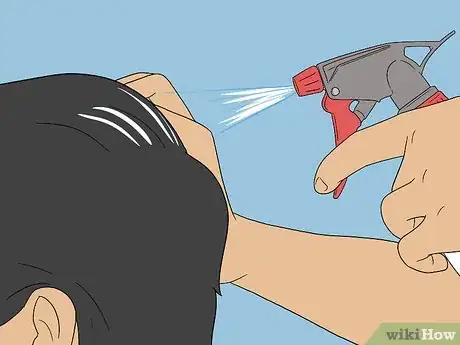
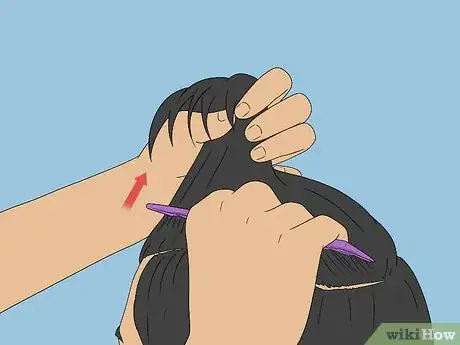

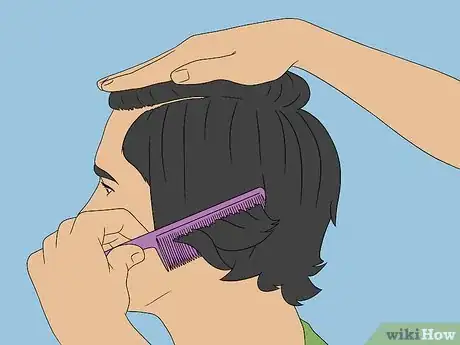

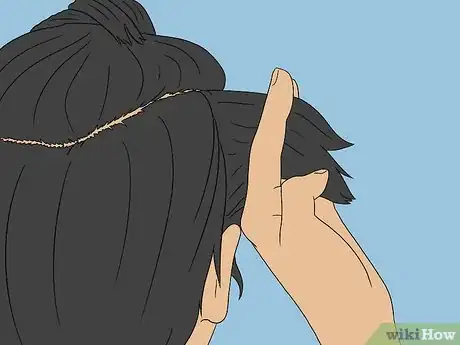
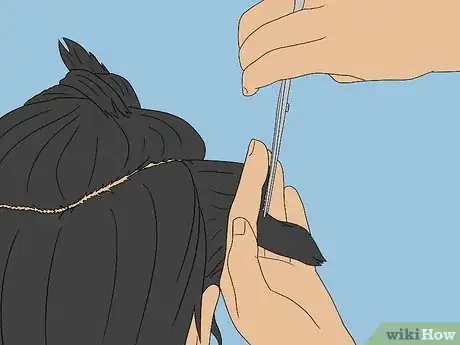

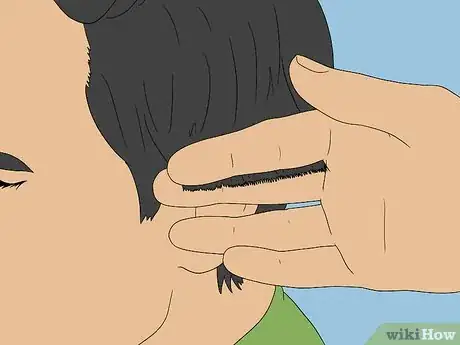
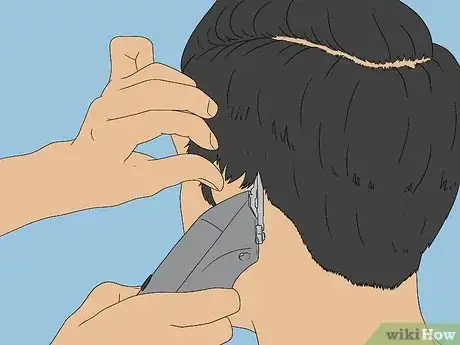
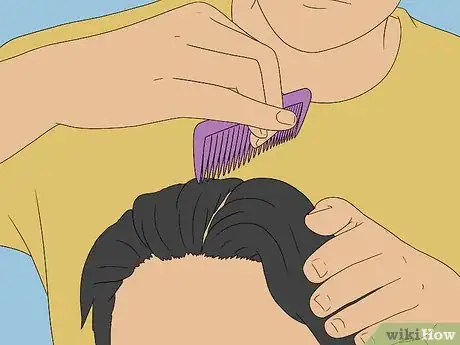
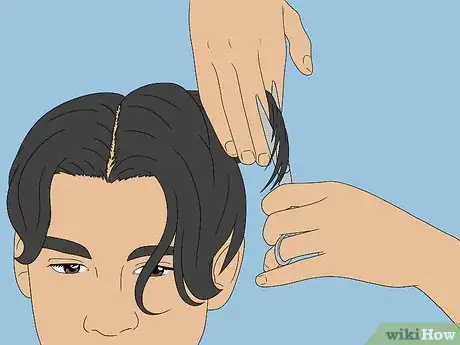

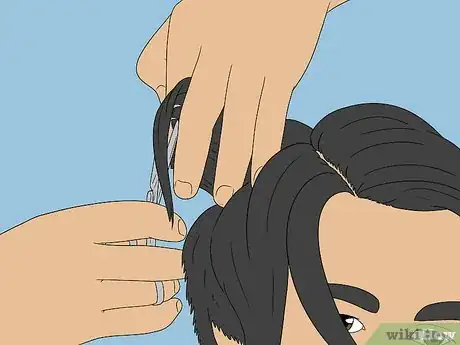
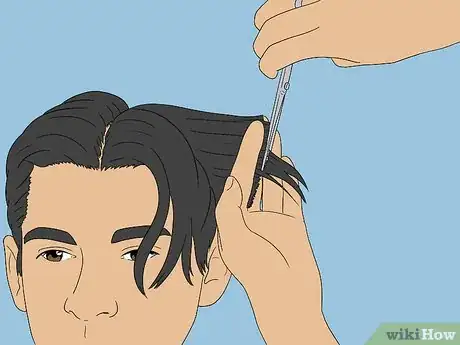
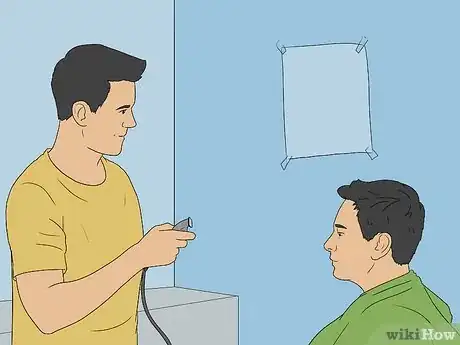


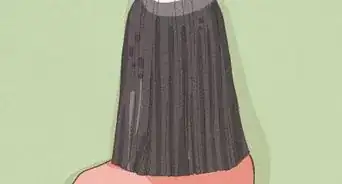
-Step-18-Version-2.webp)
